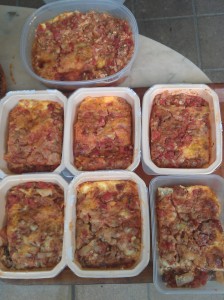Bio-individual Lasagna
When you change your diet due to dietary restrictions such as a new food intolerance, or simply a change of mind, like becoming vegetarian, a problem that you find is that you are still craving those tasty foods you used to eat before. A very popular dish is Lasagna – a pitfall dripping with lactose, gluten, and meat. So, let us explore some basic alternatives so you can adapt your own favorite recipes.
Lasagna basics. A lasagna is composed of a bottom layer of tomato sauce with meat, made by frying the meat (ground beef or turkey) with onion, garlic and salt, then adding crushed canned tomatoes and herbs (oregano, basil, marjoram – some red wine enriches the sauce and the alcohol boils away long before you eat it) and letting it boil. After spreading a layer of the tomato-meat sauce, comes a layer of pasta, followed by a thick amount of grated mozzarella cheese. Repeat with another layer of sauce, pasta and now a cottage cheese-ricotta-eggs-herbs mixture. Finally another thick layer of mozzarella.
You can find a full recipe of this tasty gluten-free lasagna from the picture above here.
If you have gluten intolerance, you will need to replace the pasta itself. Alternatives are: gluten free pasta (not always tasty or healthy, and always very expensive), pancakes made of gluten-free flours, or why not go completely paleo and use layers of zucchini, or aubergine or leek (cutting open the sheets along the length and giving them a quick boil to soften them before using them).
If you are using béchamel sauce in your recipe, you can make the white sauce with Maizena (corn starch).
If you are lactose intolerant you can try lactose-free cheeses (if available and priceworthy) but in my case I do not tolerate milk protein either, so I substitute dairy products entirely with a mix of coconut milk with whipped egg – this hardens into a white-ish layer that resembles melted cheese.
This is my Paleo Lasagna with zucchini. The white thing you see is coconut milk with egg.

If you are vegan or otherwise avoiding meat, you can replace it with texturized soy very easily. But if you are also avoiding the much gene-modified soy, you can try different creative alternatives: beans in tomato sauce! Tofu in tomato sauce! (well that’s soy too) Use the tomato sauce instructions and replace the meat with your preferred alternative (keeping the flavor of the garlic, onion, herbs and wine). Or ditch the tomato sauce and try fried onion with spinach, pine nut seeds and raisins.
Going “gluten-free” by replacing the same gluten-rich foods with their synthetic and pricey alternatives is by far not the best option. Gluten-free replacement foods (such as bread, cookies, pasta you can find in the supermarkets) often have huge amounts of chemical compounds, sugar, and starches. It is much easier, cheaper and healthier to just switch over to whole foods (for instance, replacing pasta with zucchini).
Note: don’t freak out about following a recipe exactly as it’s written! You can often create even tastier versions by tweaking it your way.
Lasagna takes a fair amount of time to prepare, but a great thing about it is that the recipes make pretty large batches, so you get a lot of extra servings to keep in the freezer for future quick meal solutions. This is another batch of lasagna I made a couple years ago, with the pancake variant. It made 9 servings.
Have fun adapting your favorite recipe according to your own bio-individual needs and enjoy this tasty meal without feeling guilty – or sick. 🙂
 Shamay Holistic Solutions
Shamay Holistic Solutions
